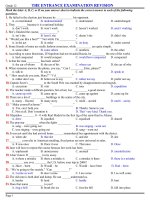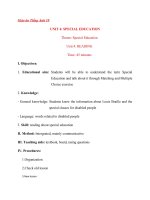Unit 4: SCHOOL EDUCATION SYSTEM D.WRITING
Bạn đang xem bản rút gọn của tài liệu. Xem và tải ngay bản đầy đủ của tài liệu tại đây (79.19 KB, 10 trang )
Unit 4: SCHOOL EDUCATION SYSTEM
D.WRITING
In about 150 words, write a paragraph on the
formal school education system in Vietnam,
using the information given in Speaking
Tasks on page 47. You may follow the
suggestions below:
-Level of education : primary ( 5 years: start
from the age of 6)
lower secondary :(4 years)
upper secondary (3 years)
- Compulsory education : 9 years (primary và
lower secondary)
-The academic year : 35 week (9 months,
from September to May)
-School term : 2 term: term 1 (Sept - Dec)
term 2 ( Jan – May )
-Time of the national examination for
GCSE (early June)
1.
Education is one of the most important factors to
help one nation develop. For this reason, Vietnamese
education system is divided into 4 levels, such as pre
– primary, primary, lower secondary and upper
secondary to manage easily and effectively.
Public Kindergarten usually admit children from
the age of 3 to 5. Children at 4 or 5 years are
sometimes taught the alphabet and basic math. The
level of education is only popular in major cities. In
remote areas, children at this age are often at home
with grandparents.
Children normally start their primary education at
the age of 6. This level lasts 5 years and it is
compulsory for all children. For this reason, the
literate proportion of Vienam is population is very
high, over 90% on average.
After the primary education, children go to the
lower secondary school. This level lasts 4 years and
is compulsory as well. This educational level is
generalized nearly throughout Vietnam, except in
very remote provinces.
The last level is the upper secondary. It last 3 years
and is optional. After 3 high school years, all students
must attend a graduation exam for GCSE. This exam
is the most important for each student is life because
they can not take part in the University Entrace Exam
without GCSE.
Although the government divides the education
system into 4 levels, there levels still have some
similar features, for instance, the academic year
consists 35 weeks. It means 9 months, from
September to May. And there are 2 terms is each
academic year in each level.
Whatever forms the government divides the
education system of Vietnam into, they should not
forget the mission of education which is knowledge.
Knowledge is the key of success.
2.
The formal school education system in Vietnam is
divided into three levels, known as the preschool,
primary and secondary. The preschool (mau giao)
level is quite comfortable, the children don’t really
have to go to school. Instead, the 3-4 year-old-kids
can go to childcare when the ones from 4-5 ages go
to kindergartens. The second level is the primary
level. This level consists of five grades, from the first
grade to the fifth grade. It is for kids from 6 to 10
years of age. The last level is the secondary level, and
just like the primary level, it’s compulsory. The
secondary level is divided into two small levels, the
lower secondary and the upper secondary. The lower
secondary has four grades, from six to nine, and it’s
for students of 11-14 ages. The upper secondary has
three grades, from ten to twelve and it’s for students
of 15-17 ages. And by the end of the upper
secondary, the students have to take the national
examination for GCSE.
3.
education system in Vietnam will be divided into 3
steps are steps kindergarten, elementary and
secondary schools. At the kindergarten level of
discretion, children are not required to go to school.
from 3-4 years old children are learning at home
while children from 4-5 years old children are
learning at grade level study sample giao.va 2nd level
is elementary. It steps including 5 classes from grade
1 to grade 5 for children from 6-10 years old. final
step is to study at secondary school. It is also the
course taken steps buoc.va it is divided into 2 levels:
level 2 and level 3. Level 2 includes the 4 layers from
grade 6 class 9 and for bringing children from 11-14
years old. grade 3, it consists of 3 layers are 10,11,12
and for students from 15-17 years old. and the end of
grade 3 students will have to test to get with them.
4.
The current formal education in Vietnam is
composed of three levels: pre-school, primary and
secondary education. Now there are two school
systems in pre-school and primary education in big
cities: state and private schools. In state school,
parents have to pay tuition fee. The academic year
from September to May is divided into two
semesters. Children usually start the pre-school at the
age of 3, when they go to nurseries, but this stage is
not compulsory. When children reach the age of 6,
they must go to primary schools. The primary
education lasts five years. When they complete their
primary education, they can go to secondary schools,
including Lower and Upper schools, from grade 6 to
12. However, children must pass a entrance exam at
the end of grade 9, the final year of lower schools, to
enter the upper secondary education. They will stay
there until they complete grade 12. At the end of this
stage, they must take the National Examination for
GCSE, the requirement to go to university or college.
This examination often takes place at the end of May
or early June.
5.
There are three levels of the school education system
in Vietnam: pre-school, primary and secondary
education. First, the pre-school start from the age of 3
to 5. However this level is optional. Second, the
primary education lasts 5 years from grade 1 to grade
5 and the Vietnamese children usually start grade 1 at
the age of 6. The secondary education has two levels:
lower and upper secondary schools. The lower
secondary lasts 4 years & the upper secondary lasts 3
years. The academic year runs from September to
May and is divided into 2 terms. Besides, the
compulsory education lasts 9 years from grade 1 to
grade 9. When the pupils finish the secondary
education, they have to take the national examination
for GCSE to go to university or college. It take place
in the beginning of June.
6.
There are three levels of the school education system
in \vietnam. First of all, the primary education often
lasts 5 years from grade 1 to grade 5 and the
Vietnamese children usually start grade 1 at the age
of 6. The secondary education is divided into two
levels: lower and upper secondary schools. The
compulsory education lasts nine years from grade 1
to grade 9. besides. the academic year in Vietnam
consists of 35 weeks from September to late May.
There aretwo term in each school year. When
students finish the secondary education, they have to
take the national examination of GCSE. It is often
held in the early June. After that students can stop
studying to find jobs or they take the university
entrance exam in the early July. However, students
will be taking the national examination of GCSE and
then they will submit their marks to win a place in the
university.
7.
There are three levels of education in the formal
school system in Viet Nam: pre-school, primary and
secondary education. The academic year is divided
into 2 terms. It lasts 9 months from early September
to the end of May. The first term is from September
to December and the second term last from January
to May. Children usually start the pre-school at the
age of 3 when they go to nursery and kindergarten,
but this stage is optional .When children start going
to primary school at the age of 6. After 5 years, they
move to lower secondary school where they study in
4 years. When they complete their secondary school,
they spend 3 years studying at upper secondary
school. They finish secondary education at the age of
seventeen. Schooling is compulsory for Vietnamese
children in 9 years( primary and lower secondary).
However, children must pass an entrance exam at the
end of grade 9 to enter the upper secondary
education. They must take the National Examination
for GCSE, the requirement to go to university or
college. This examination often takes place at the end
of May or early June.
8.
There are two levels of school education in Vietnam:
primary and secondary.Children in Vietnam begin
primary school at the age of six and move to lower
secondary school when they are eleven.They spend
four years there and then three years (studying) at
upper_secondary school.They finish secondary
school at the age of seventeen.Schooling is
compulsory for Vietnamese children until they finish
lower_secondary school.The duration of the
academic year is 35 weeks from September to May
and is divided into two years,The first term is from
the beginning of September to late December and the
second term starts in early January and end in May.A
National Exam GCSE is held in June for all students
who have finished upper_secondary school.Those
who have passed this GCSE are able to take the
university and college entrance exam in July.
9.
In Vietnam, there are three levels of education: Pre-
school, Primary school and Secondary education. The
academic year lasts 35 weeks divided into 2
semesters: the firrt is from September to December,
and the second is from January to May. Children
often go to Nursery when they are three, and after
that, they will go to Kindergarten when they are four;
but these are not compulsory. Until children are six,
they have to study at Primary school. This stage lasts
five years. After completing the Primary level,
children can take part in Secondary education,
including Lower and Upper Secondary from grade 6
to grade 12. However, before entering grade 10, the
first year of Upper Secondary, children must pass an
entrance exam. After completing grade 12, students
will take a National Examination for GCSE before
taking the entrance exam to university. This
examination is often held in early June.









